
|
Steam
Locomotion in the 21st
Century
The Recent
History of Steam Locomotive
Development
|
Modern "Live
Steam" Engineers
updated 28 January
2022
While most of these pages cover the
development of "full sized" steam
locomotives, another field of steam
technology development exists. Coincident
with the decline of mainline steam
activity in the 1950's a new hobby sprang
up. All over the world, enthusiasts began
building miniature working steam
locomotives to satisfy their "thirst for
steam". "Live steam" clubs formed and
built tracks where enthusiasts could
operate their locomotives. These
locomotives are actual fuel-burning,
smoke-belching, steam engines and exhibit
all the properties (good and bad) of their
full-sized counterparts. A very common
scale for these miniature engines is 1-1/2
inches to the foot, which gives engines
which are big enough to pull several cars
carrying adult passengers.
Traditionally, most live steam
locomotives are technologically simple.
Craftsmen build their engines in garages
or workshops, and hence simple
construction, easy operation and good
reliability are sought-after qualities.
Accessories such as superheaters,
feedwater heaters, and efficient exhaust
systems are rarely used. Fuel efficiency
is generally disregarded due to the
relatively small size of these engines
relative to that of the operators.. The
full-sized fireman has no trouble stoking
the firebox, regardless of how inefficient
the engine is.
Despite this, several live steam
enthusiasts have been interested in
building more-complex models. For
instance, one in the UK has constructed an
authentic replica of one of Chapelon's
compound French Pacifics. Other
enthusiasts have seen the practical value
of implementing the improvements developed
by Chapelon, Porta, Wardale, et al to
their miniature steam locomotives. They
also see the possiblity of using miniature
locomotives as research platforms for
developments which can be applied to
full-size steam locomotives.
Michael
Guy
Googling "Lempor exhaust" will turn up
information on quite a few Lempor
installations on live steam locomotives
around the world. This is chiefly due to
the work of Michael Guy of Canada, who not
only fit his own locomotive with a Lempor,
but developed a spreadsheet for sizing the
components of a Lempor for any
locomotive. You can read more
about Michael's work, see photos of
several live steam Lempor installations,
and access his Lempor Exhaust spreadsheet
here: http://home.ca.inter.net/~mguy/index.htm
John Davies ( Model Engineer )
(Information
provided by John Davies) While the
building of miniature steam locomotives
might be far removed from full size rail
operation, and be considered to be
expensive toys for rich boys, there is a
serious side to this hobby. Engineering
of the highest standards is often
practiced, which has the potential to
allow steam locomotive development to be
conducted at a fraction of the cost
associated with full size operations.
HUMBLE BEGINNINGS
In 1991 a single garage was converted into
a simple workshop and with the minimum
equipment a start was made to build a 1/6
scale Lynton and Barnstable locomotive
(LEW). During the next six years every
component was redrawn (the plan was to a
different scale) and manufactured. As
boilers do not scale this major item was
re-designed using model boiler calculation
guidelines.
John's first experimental steps were
taken by casting the cylinders and axle
bearings using aluminium (aluminum) alloy,
which has worked well on this saturated
steam locomotive which is seen below.

Lady Carol -
The sole motive power at the Secunda
Steamers in South Africa for the last 3
years. Has pulled heavy trains, covering a
distance of 15 000 scale Kilometres in the
process. While the building and running of
this locomotive and the training of many
drivers, was an enjoyable hobby, a greater
challenge was sought.
A CHANGE OF DIRECTION
During 1998 John acquired a copy of David
Wardale's The Red Devil. An
in-depth study of this very informative
volume left him convinced that the steam
locomotive at the height of its reign, was
not only grossly under-developed, but that
the standard Stephenson layout severely
limited the potential to compete with the
diesel. He had found the doorway to a new
journey in steam. A miniature locomotive
of a different concept would be the way
forward to prove that steam can be
competitive in this modern world.
THE GPCS TRIALS
After reading The Red Devil, John was
particularly intrigued with the idea of
the Gas Producer Combustion System (GPCS)
developed by L. D. Porta and applied by
Wardale to locomotives in South Africa.
Lady Carol had experienced problems with
"clinkering" of her fire and this
sometimes caused problems during
operations at the Secunda Steamers track.
The GPCS seemed to offer major benefits
for operation of this locomotive. Further,
John reasoned that if the GPCS system,
which needed a deep coal bed, could be
made to work in a miniature locomotive,
that most, if not all characteristics of
the steam locomotive could be scaled in
both directions. If this were true, then a
cheap, cost efficient way had been found
for steam locomotive development. With
advice from a small group of knowledgeable
enthusiasts ( the S-TEAM ), Lady Carol was
modified to use incorporate GPCS
combustion via relatively simple
modifications. This trial was conducted
with success on a grate of 42 square
inches and a firebed depth of 3 inches.
This story is covered in more detail in
the paper "The Miniature Steam Locomotive"
(1999).
A NEED IS IDENTIFIED
During 1999 the concept of a locomotive
with 100% adhesive weight, allowing a high
TRACTIVE EFFORT to weight ratio, which
could run at moderate speeds on poor track
beds would be ideal for oil starved
developing countries. The ability to use
any available solid fuel was called for.
Furthermore local construction with the
maximum possible local content, which
would boost the countries manufacturing
industry would be necessary. A fully
modular construction using simple
technology would be necessary to avoid
prolonged downtime during maintenance
would be essential to allow competition
with diesel traction.
With the help of the S-TEAM, the year
2000 saw the birth of the concept, this
steam locomotive will have the appearance
of a diesel and provide similar crew
comfort. The locomotive will run on
self-steering bogies having from two to
four axles. These bogies will be powered
by a piston valve four-cylinder steam
engine placed above them. The boiler will
be of high efficiency producing
superheated steam and including a
preheater and fired by a GPCS firebed,
which will be drafted by a Lempor exhaust
system. The modular system will allow fuel
and water to be carried on board for
short-range duties or to be fitted with a
tender for long range operation in the cab
forward mode. The dry walled fire bed area
can be changed for different fuels used.
THE PROTOTYPE
Construction drawings for a 7-1/4 inch
gauge prototype were begun. Construction
was expected to begin during 2001 and was
expected to take between 3 and 5 years.
(Not known if this was accomplished.) A
sketch of the proposed locomotive can be
seen below. After a period of testing and
tuning, further development is expected to
be an ongoing process. Will this exercise
lead to a new generation of commercial
steam locomotives? Time will tell!
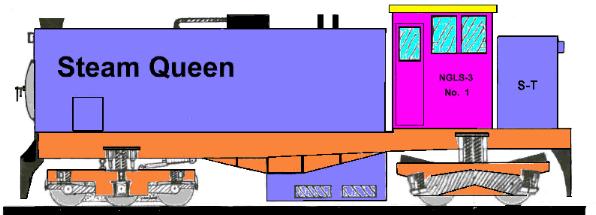
John also developed a coal-fired cooking
stove using the Gas Producer Combustion
System principal to reduce smoke an
emissions. Read more about it here:
http://bioenergylists.org/stovesdoc/Davies/davies.html
Live steam enthusiasts and others
interested in this project may contact
John via e-mail at: jmdavies@telkomsa.net
Wolf Fengler
Wolf Fengler has a masters degree in
mechanical engineering from UCLA and
currently serves as a principal and
mechanical engineer at FMW, LLC. Wolf's
serious involvement with steam locomotives
began at the age of 11 at the local live
steam track. Since that time, he has
helped to build a locomotive, operated
numerous model steam engines, spent much
time researching steam locomotive
developments and corresponds with steam
locomotive experts from around the world.
In addition to his involvement in the Live
Steam hobby, he is also active with the
San Bernadino Railroad Historical Society,
which maintains and operates former
AT&SF 4-8-4 #3751. He is also the
first to admit that he has a lot to learn.
The year 1985 was quite pivotal in the
development of his interest in steam
locomotives. This was the year that he
convinced his Dad that they should build a
live steam locomotive. It was also the
year that Ross Rowland and the ACE 3000
team took ex C&O 4-8-4 #614 out on the
mainline to acquire test data. An issue of
Railfan & Railroad from May of that
year contained a wonderful article on the
months long testing back East that fired
his imagination. It also contained a small
two (2) page report on the work of a young
engineer named David Wardale In South
Africa on a locomotive nicknamed the "Red
Devil."
The inspiration for the improvements to
the locomotive came from reading that
article and others about Chapelon, Porta
and Wardale, as well as experience
garnered operating the engine coupled with
engineering knowledge from other fields.
The coal-fired locomotive features:
- A thermic syphon
- Smokebox throttle, upstream of the
superheaters (would be better
downstream, but there were space
constraints)
- A large diameter, streamlined dry pipe
and steam supply lines to the cylinders
- Two, full firebox depth arrowhead type
stainless steel superheater elements of
the same diameter as the main dry pipe
- An Inconel grate
- A feedwater heater consisting of a
copper pipe coiled around the inside
diameter of a portion of the smokebox
- Radiused exhaust ports a la New York
Central Niagaras
- Individual streamlined exhaust
passages which collect in a central
blast pipe
- A four-lobed exhaust nozzle sized per
the recommendations of Jos Koopmans and
L.D. Porta
- A triple-venturi petticoat arrangement
for the exhaust which somewhat emulates
a Kylchap 1-C
- A conical stack extension which serves
to keep cinders and fumes away from the
operator and helps extend the diffuser
length
- A master mechanics self-cleaning
smokebox arrangement was fitted for a
time. It was quite effective, but was
removed to facilitate cleaning and an
increased draft for testing the gas
producer combustion system (GPCS). A
simple wire screen around the petticoats
now serves as a spark arrester.
- Synthetic, lube-free bearing material
for the connecting rods and needle
bearings on the main rods. Miniature
roller bearings were tried in the
Walshaerts valve motion and work alright
except in the die block, where they have
been replaced with more conventional
bearing material
- Automotive style seal rings for the
pistons
- An arch (several types of different
shapes and materials have been tried)
- GPCS firebox: a needle valve tapped
off the turret supplies clinker control
steam, which works quite well when
coupled with the occasional stir.
Secondary air was provided via control
of the fire door opening and several
short steel tubes which came up through
the grate. This work predated the
publishing of David Wardale's book, so
the primary/secondary air ratios were
purely guess work as no technical advice
was readily accessible at that time. The
tubes quickly burned out and no further
work has been completed due to time
constraints. However, when the tubes
were still functional, a noticeable
improvement in firing was detected. A
coal crusher was also constructed to
provide "scale" sized coal pieces to
obtain the necessary firebed depth, once
that information was available. This
improved GPCS operation, but increased
the occurrence of caking.
Future planned improvements included:
- A new arch featuring integral
secondary air passages
- Wire coil type enhanced heat transfer
surfaces in the fire tubes to improve
heat transfer without interfering with
tube cleaning
- A redesigned grate/ashpan better
incorporating the findings of Wardale
and the latest theories of Porta
- Improved insulation
In addition, initial designs are slowly
being readied for a Kittson-Meyer/Garratt
hybrid that will feature compounding, a
Porta sectional boiler, combustion air
pre-heaters, a form of dynamic braking, a
newly designed valve gear system and,
hopefully, some control systems that will
point the way toward multiple unit steam
locomotive operation.
After finishing his masters, Wolf worked
in the fuel cell industry for several
years. Later, he worked for noted rail
enthusiast and American Coal Enterprises
founder Ross Rowland, before becoming a
co-founder of FMW (Fengler-Meador-Ward)
Solutions, LLC. FMW is involved in both
commercial and tourist industry rail work,
including steam locomotive rebuilding and
improvements. Wolf is also a volunteer
with the Pennsylvania T-1 Steam Locomotive
Trust, and is designing the all-welded
boiler incorporating current code
requirements and fabrication techniques
for the project.
Andrew Matthews
(updated June 19, 2005)
Andrew had sent me information on a
couple of planned projects in 2002 (see
below), and recently sent me info on some
recent live steam progress in Australia.
(Below photos by Andrew Matthews except as
noted.)
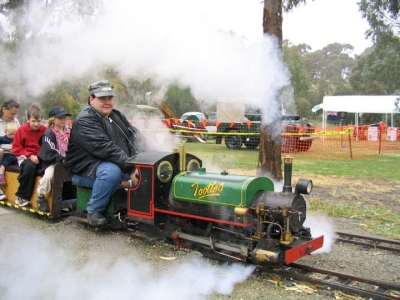
"Tootles"
"Tootles" is a 7-1/4" gauge
0-4-0ST which was recently refitted with a
new Lempor exhaust system, smokebox (all
stainless steel construction) and
streamlined steam circuit. The photo above
shows the locomotive in pre-modified
condition. Andrew provides this assessment
of the modified locomotive's performance:
"Suffice it say the loco in question has
approximately 20% more horsepower and
almost has a silent exhaust when not
working hard earning a nickname similar to
Wardale's modified 19D (an SAR 4-8-2)
"Spooky". The following photos show the
smokebox and exhaust during fabrication as
well as the completed locomotive. Of great
interest, Andrew notes that the Lempor
exhaust has now become almost the
"standard" system at their track with no
less than 4 locomotives under construction
with Lempor exhausts.
|
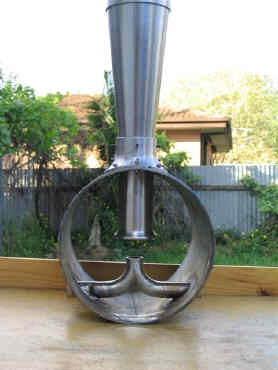
|
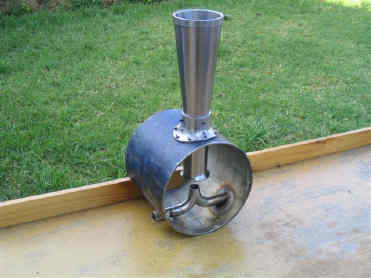
|
New Smokebox
with Lempor Exhaust
|
New Smokebox
with Lempor Exhaust
|
|
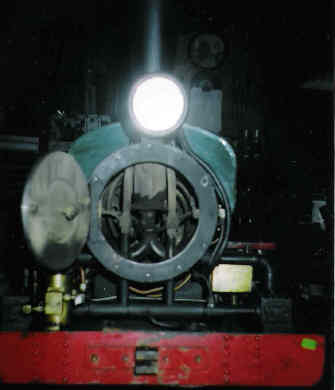
|
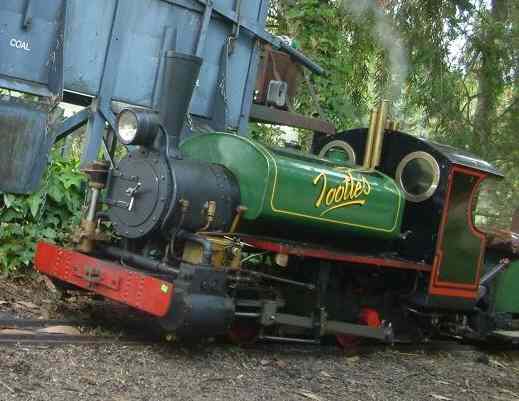
|
Lempor
Exhaust Installed
|
"Tootles"
with Lempor Exhaust
photo by
David Head
|

Lempor-equipped Tootles
on Train
Andrew submitted the
attached highly detailed technical paper
on the design, fabrication, and testing of
the Lempor Ejector for Tootles. Highly
recommended reading for live steamers and
full-size steam enthusiasts alike:
Thermodynamic
Improvements to an 0-4-0ST Engine in
7-1/4" Gauge
Andrew's original info
follows:.
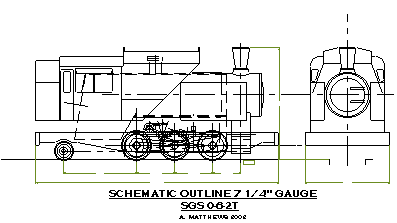
The following comes from Andrew Matthews,
a live steamer from Australia:
"I have noticed on your website that you
have included a section on "live steam"
Engineers and thought that you may be
interested in some projects that
myself and another member of our model
engineering club in South Australia,
Roseworthy Railway have been working
on. Between the two of us we
currently have three high power
designs that we are
drawing for 7 1/4" gauge, One of
which is under construction at present.
These designs. are utilising many of the
principles as explained by Porta, Wardale
& Chapelon. The wheel
arrangements of these locos: are an
0-6-2T, a 2-6-0, and a 2-10-4.
The main features common to all are:
- Ball races to all running surfaces
where at all possible.
- Minimisation of reciprocating and
unsprung weight.
- Porta high adhesion tyre profile.
:
- Computer modeled valve gear.
- Improved cylinder porting.
- Mechanical cylinder lubrication.
- Use of modern contempary alloys for
many parts.
- Use of polymeric materials for some
wear and sealing components.
- Cylinders designed with smaller
clearance volumes and large steam chest
volume.
- Enlarged, enhanced steam curcuit.
- Steel loco type boiler to A.M.B.S.C.
standard.
- Very high superheat for a model
utilising full radiant superheaters
(350+ deg.C)
- Large combustion volume firebox and
arch tubes
- Steel firebox arch
- Feedwater heating (80 to 90 deg.C)
- Fully compensated braking system.
- Lempor exhaust.
- Downstream high-flow smokebox throttle
- Steam chest and exhaust back pressure
gauges.
- Smokebox manometer.
- Turbo feedwater pump (centrifugal).
(Note: This item I am currently
researching as to it's feasibility in a
small scale utilising NASA data gathered
from their fuel pumps.)
- Speedometer
The next list applies only to the 2-6-0
and 2-10-4.
- Gas producer Combustion system.
- Steam heated cylinders.
- Fully compensated suspension system.
- Digital water gauge for night running.
- Thermocouple telemetry of firebox,
smokebox & superheat temperatures.
- Long range tenders.
- Heavy frame superstructure to increase
tractive weight.
- Exhaust equalising piston valves
:Aircraft aluminium(7075) coupling and
conrods.
- Some aluminium motion parts
- Multiple bearing crosshead.
- Long travel baker valve gear.(needle
roller throught running on nitrided
pins).
- Max. cutoff 72.5%.
So far the material for the frames,
smokebox saddle, axleboxes,wheels,and all
bearings needed have been purchased and
the saddle fabricated for the 0-6-2T.The
design of the 0-6-2T is about 40%
complete. I hope to have that running mid
2004. My next project after that will be
the 2-10-4 which is still very early in
the design process.
Originally, the tank engine was to have
been an 0-6-0T however this was later
revised to an 0-6-2T configuration.
Firstly, moment of inertia calculations
revealed that with the 0-6-0T
configuration there was an inordinate
amount of weight and therefore energy
hanging over the back end of the loco.
This would likely result in much bobbing
up and down which any springing system
would be hard pressed to absorb. Secondly,
Andrew's father for saw an illustration of
Porta's 0-6-2T and decided he wanted the
same outline and layout hence the
similarity. The 2-10-4 is based on nothing
in particular but is very much a
combination of all the desirable features
Andrew likes in a locomotive.
American,French and Australian practice
are the main influences.

Just a little about myself. I am
middle-aged and work as a toolmaker in the
medical industry. I completed year 12
studying maths, physics, chemistry,and
metalwork. I have been interested in steam
locos since I was about 3 years old
and the affliction gets worse every year!.
I am currently the secretary for our club
and also the club boiler inspector. "
It certainly sounds like Andrew and his
model engineering club are doing some
cutting edge live steam engineering down
under. Updates on their progress will be
posted as they become available.
Tony Hubner
I recently received some info and
drawings on a proposed 3-1/2" gauge, 3/4"
= 1' scale modern live steam locomotive
from Tony Hubner of Victoria BC Canada.
Tony is a lifelong steam enthusiast and
has built several small steam locomotives.
In addition he is presently working on a
steam boat and a three-wheeled steam car.
Tony and his son run Meg Steam
Incorporated, which produces narrow-gauge
0-4-0's for 7-1/2" gauge. Even his wife is
involved in the live steam hobby,
currently working on an English inside
cylindered 0-4-0.
Tony's proposal is for a B-B two-truck
type steam locomotive with an engine hung
on the sideframes of each truck. The rear
engine would be high pressure; the front
would be low pressure (compound
expansion). Drive to the wheels will be by
roller chains. An all-copper boiler
provides steam at 120 PSI, with a radiant
superheater providing highly superheated
steam, routed through a heat exchanger to
re-heat receiver steam while slightly
cooling the steam for the HP cylinders.
The boiler will be coal-fired and will
have a firetube barrel with a watertube
firebox. The various parts are to be
mounted on a frame and cased in like a
diesel, with a cab at the back at a firing
station at about the mid-point. The
smokebox projects from the front for
appearance and ease of tube cleaning.
Tony goes on to say "The ultimate end of
the project would be to take it to England
for the annual International Model
Locomotive Efficiency Competition or
IMLEC." Sketches of the proposed
locomotive are included below:

Proposed 3-1/2" gauge B-B
Modern Steam Locomotive
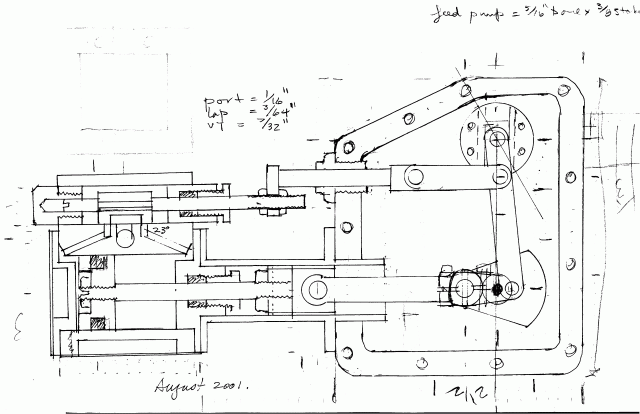 |
This drawing shows
one of the two enclosed steam
"motors" for the prosed
locomotive. |
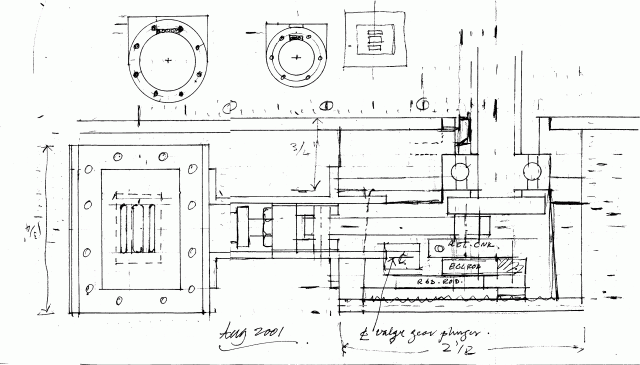 |
A top view of the
steam motor, also showing the
relative sizes of the HP and LP
cylinders, and the valve gear
arrangement. |
I look forward to hearing more from Tony
on this very interesting engine proposal.
|